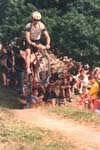Marin County, California is regarded by many as the birthplace of mountain biking. In the 70's those daredevil downhill riders couldn't have imagined what affect their "clunkers", on balloon tyres, would have on the cycle industry.
 Mountain bikes (MTBs) were first produced commercially in the early eighties and it's probably fair to say it brought about an explosion in sales and use of the bike.
Mountain bikes (MTBs) were first produced commercially in the early eighties and it's probably fair to say it brought about an explosion in sales and use of the bike.
The reason for this could be that the MTB can certainly be referred to as an "all rounder". Dependent upon tyre choice, an MTB can be equally at home on the road, or relaxing cycle paths or climbing the highest mountain. Most MTBs use 26" wheels and when off road big is best when it comes to tyre selection.
Today all mountain bikes have derailleur gearing and nothing primitive. Almost all are indexed and come in quantities up to 24 (unless of course they've now developed the 27). This makes changing gear to maintain your cadence very easily, no more the "3 up and 2 down" to get the gear you want.
Braking also has improved dramatically and now bikes can be stopped literally on a sixpence (or 20p piece). As for comfort, well, they're for going downhill fast really, but how about a full suspension mountain bike.
A short note about sizing yourself for an MTB, our suggestion is 3-5 inches between the top tube of the frame and your essential parts. This distance can reduce the possibility of a painful coming together.